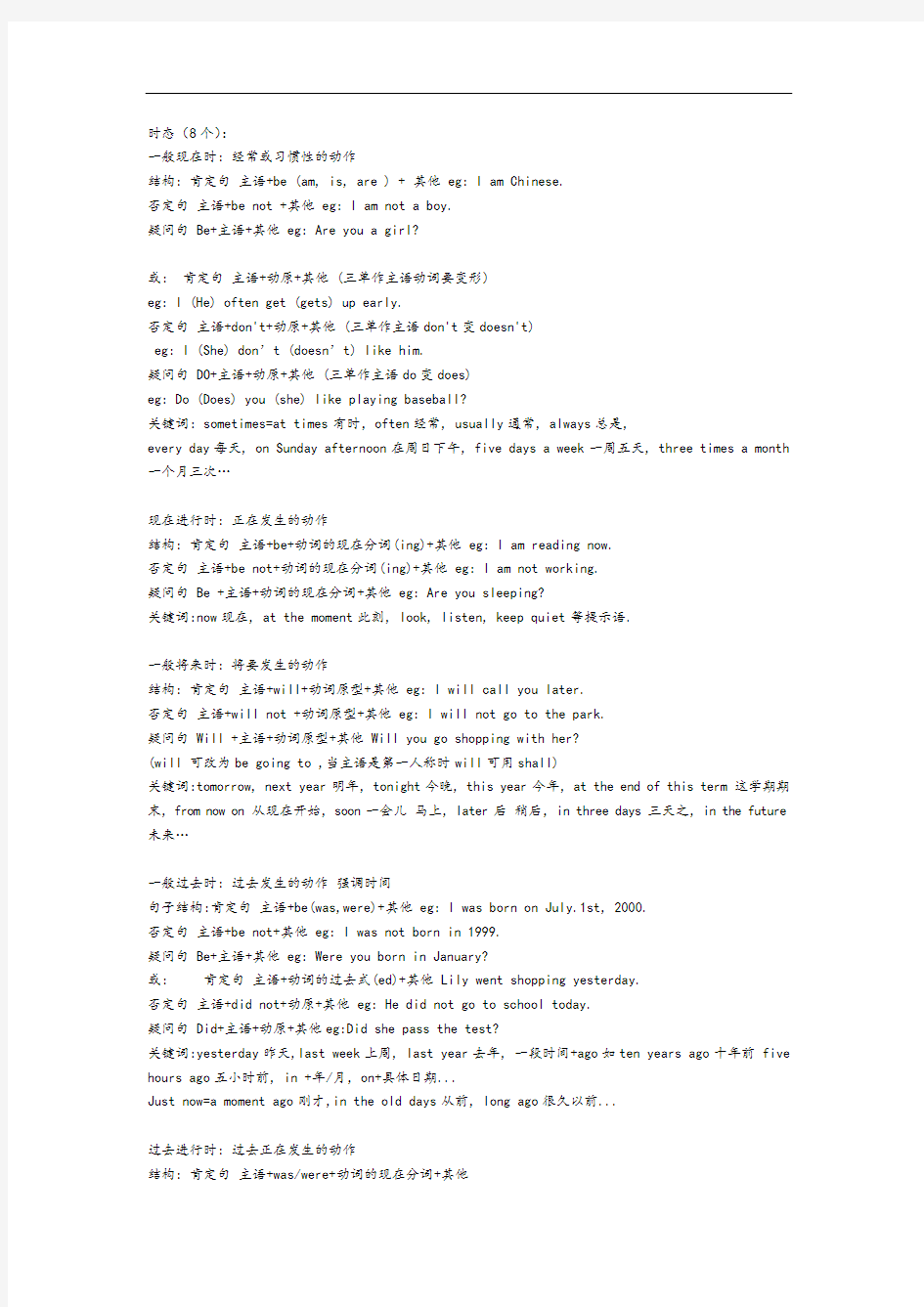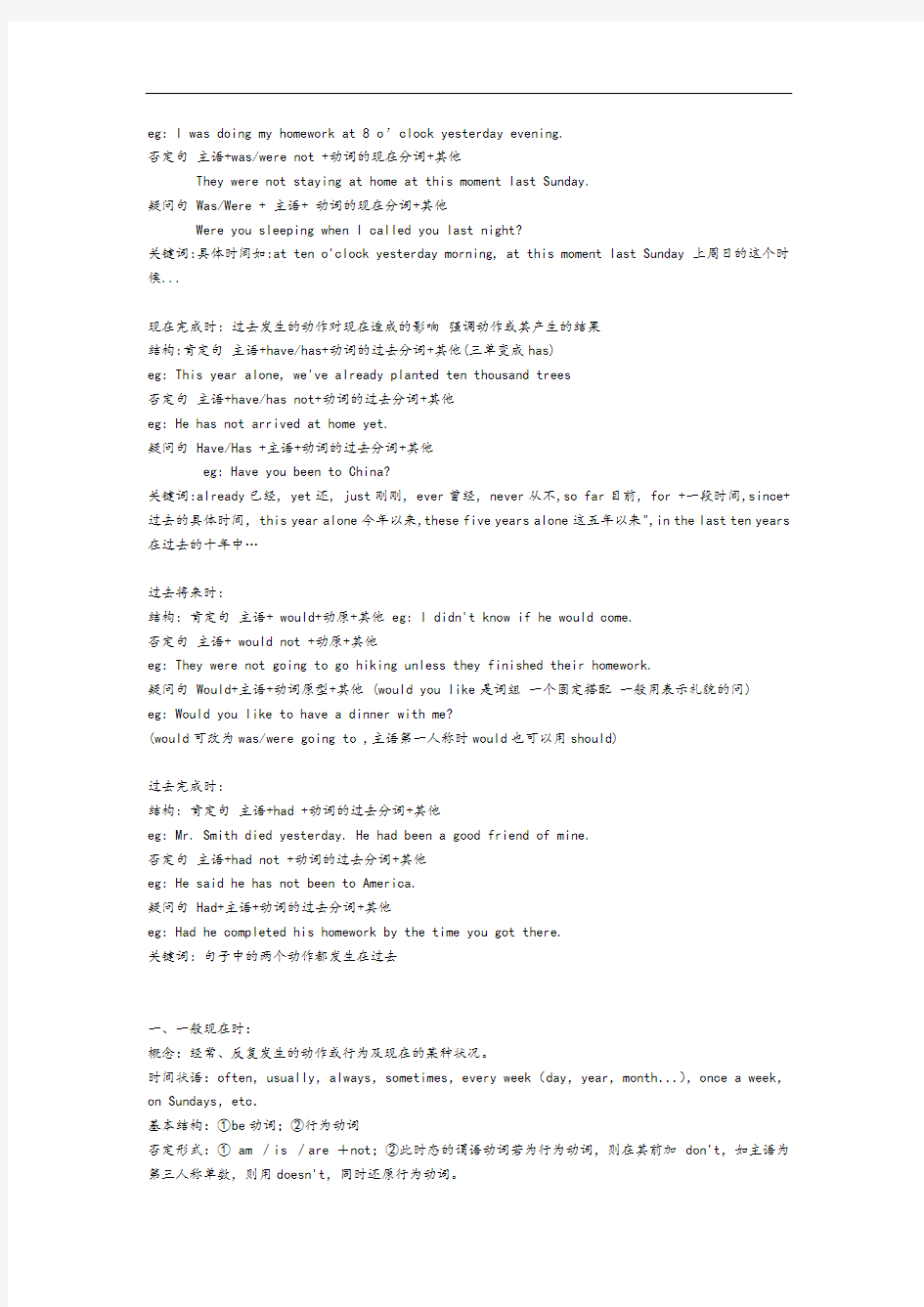英语八大时态结构_含例句


时态(8个):
一般现在时: 经常或习惯性的动作
结构: 肯定句主语+be (am, is, are ) + 其他 eg: I am Chinese.
否定句主语+be not +其他 eg: I am not a boy.
疑问句 Be+主语+其他 eg: Are you a girl?
或: 肯定句主语+动原+其他 (三单作主语动词要变形)
eg: I (He) often get (gets) up early.
否定句主语+don't+动原+其他 (三单作主语don't变doesn't)
eg: I (She) don’t (doesn’t) like him.
疑问句 DO+主语+动原+其他 (三单作主语do变does)
eg: Do (Does) you (she) like playing baseball?
关键词: sometimes=at times有时,often经常, usually通常, always总是,
every day每天, on Sunday afternoon在周日下午, five days a week一周五天, three times a month 一个月三次…
现在进行时: 正在发生的动作
结构: 肯定句主语+be+动词的现在分词(ing)+其他 eg: I am reading now.
否定句主语+be not+动词的现在分词(ing)+其他 eg: I am not working.
疑问句 Be +主语+动词的现在分词+其他 eg: Are you sleeping?
关键词:now现在, at the moment此刻, look, listen, keep quiet等提示语.
一般将来时: 将要发生的动作
结构: 肯定句主语+will+动词原型+其他 eg: I will call you later.
否定句主语+will not +动词原型+其他 eg: I will not go to the park.
疑问句 Will +主语+动词原型+其他 Will you go shopping with her?
(will 可改为be going to ,当主语是第一人称时will可用shall)
关键词:tomorrow, next year明年, tonight今晚, this year今年, at the end of this term这学期期末, from now on从现在开始, soon一会儿马上, later后稍后,in three days三天之, in the future 未来…
一般过去时: 过去发生的动作强调时间
句子结构:肯定句主语+be(was,were)+其他 eg: I was born on July.1st, 2000.
否定句主语+be not+其他 eg: I was not born in 1999.
疑问句 Be+主语+其他 eg: Were you born in January?
或: 肯定句主语+动词的过去式(ed)+其他 Lily went shopping yesterday.
否定句主语+did not+动原+其他 eg: He did not go to school today.
疑问句 Did+主语+动原+其他eg:Did she pass the test?
关键词:yesterday昨天,last week上周, last year去年, 一段时间+ago如ten years ago十年前 five hours ago五小时前, in +年/月,on+具体日期...
Just now=a moment ago刚才,in the old days从前, long ago很久以前...
过去进行时: 过去正在发生的动作
结构: 肯定句主语+was/were+动词的现在分词+其他
eg: I was doing my homework at 8 o’clock yesterday evening.
否定句主语+was/were not +动词的现在分词+其他
They were not staying at home at this moment last Sunday.
疑问句 Was/Were + 主语+ 动词的现在分词+其他
Were you sleeping when I called you last night?
关键词:具体时间如:at ten o'clock yesterday morning, at this moment last Sunday上周日的这个时候...
现在完成时: 过去发生的动作对现在造成的影响强调动作或其产生的结果
结构:肯定句主语+have/has+动词的过去分词+其他(三单变成has)
eg: This year alone, we've already planted ten thousand trees
否定句主语+have/has not+动词的过去分词+其他
eg: He has not arrived at home yet.
疑问句 Have/Has +主语+动词的过去分词+其他
eg: Have you been to China?
关键词:already已经, yet还, just刚刚, ever曾经, never从不,so far目前, for +一段时间,since+过去的具体时间,this year alone今年以来,these five years alone这五年以来",in the last ten years 在过去的十年中…
过去将来时:
结构: 肯定句主语+ would+动原+其他 eg: I didn't know if he would come.
否定句主语+ would not +动原+其他
eg: They were not going to go hiking unless they finished their homework.
疑问句 Would+主语+动词原型+其他 (would you like是词组一个固定搭配一般用表示礼貌的问)
eg: Would you like to have a dinner with me?
(would可改为was/were going to ,主语第一人称时would也可以用should)
过去完成时:
结构: 肯定句主语+had +动词的过去分词+其他
eg: Mr. Smith died yesterday. He had been a good friend of mine.
否定句主语+had not +动词的过去分词+其他
eg: He said he has not been to America.
疑问句 Had+主语+动词的过去分词+其他
eg: Had he completed his homework by the time you got there.
关键词: 句子中的两个动作都发生在过去
一、一般现在时:
概念:经常、反复发生的动作或行为及现在的某种状况。
时间状语:often,usually,always,sometimes,every week(day,year,month...),once a week,on Sundays,etc.
基本结构:①be动词;②行为动词
否定形式:① am /is /are +not;②此时态的谓语动词若为行为动词,则在其前加don't,如主语为第三人称单数,则用doesn't,同时还原行为动词。
一般疑问句:①把be动词放于句首;②用助动词 do提问,如主语为第三人称单数,则用does,同时,还原行为动词。
二、一般过去时:
概念:过去某个时间里发生的动作或状态;过去习惯性、经常性的动作、行为。
时间状语:ago,yesterday,the day before yesterday,last week(year,night,month...),in 1989,just now,at the age of 5,one day,long long ago,once upon a time,etc.
基本结构:①be动词;②行为动词
否定形式:① was/were +not;②在行为动词前加didn't,同时还原行为动词。
一般疑问句:①was或were放在句首;②用助动词do的过去式did提问,同时还原行为动词。
三、现在进行时:
概念:表示现阶段或说话时正在进行的动作及行为。
时间状语:now,at this time,these days,etc.
基本结构:am/is/are +doing
否定形式:am/is/are +not+doing
一般疑问句:把be动词放在句首
四、过去进行时:
概念:表示过去某段时间或某一时刻正在发生或进行的行为或动作。
时间状语:at this time yesterday,at that time或以when引导的谓语动词是一般过去时的时间状语等。
基本结构:was/were +doing
否定形式:was/were +not+doing
一般疑问句:把was或were放在句首
五、现在完成时:
概念:过去发生或已经完成的动作对现在造成的影响或结果,或从过去已经开始,持续到现在的动作或状态。
时间状语:recently,lately,since...,for...,in the past few years,etc.
基本结构:have/has +done
否定形式:have/has +not+done
一般疑问句:have/has放于句首
六、过去完成时:
概念:以过去某一时间为标准,在此以前发生的动作或行为,或在过去某动作之前完成的行为,即“过去的过去”。
时间状语:before,by the end of last year(term,month...),etc.
基本结构:had +done
否定形式:had +not+done
一般疑问句:had放于句首
七、一般将来时:
概念:表示将要发生的动作或存在的状态及打算、计划或准备做某事。
时间状语:tomorrow,next day(week,month,year....),soon,in a few minutes,by...,the day after tomorrow,etc.
基本结构:①am/is/are/going to +do;②will/shall+do
否定形式:①am/is/are +not+going to +do;② will/shall+not+do
一般疑问句:①be放于句首;② will/shall提到句首
八、过去将来时:
概念:立足于过去某一时刻,从过去看将来,常用于宾语从句中。
时间状语:the next day(morning,year...),the following month(week...),etc.
基本结构:①was/were/going to +do;② would/should +do
否定形式:①was/were/not+going to +do;②would/should +not+do
一般疑问句:①was或were放于句首;②would/should提到句首
一般现在时讲解与练习
1.表示事物或人物的特征、状态。如:The sky is blue.天空是蓝色的。
2.表示经常性或习惯性的动作。如:I get up at six every day.我每天六点起床。
3.表示客观现实。如:The earth goes around the sun.地球绕着太阳转。
构成: 1. be动词:主语+be(am,is,are)+其它。如:I am a boy.我是一个男孩。
2.行为动词:主语+行为动词(+其它)。如:We study English.我们学习英语。
当主语为第三人称单数(he, she,it)时,要在动词后加"-s"或"-es"或变“y”为“ies”如:Mary l ikes Chinese.玛丽喜欢汉语。Miss Gu teaches us English. 顾老师教我们英语。She stud ies Chinese every day.她每天学习语文。否定句、一般疑问句、特殊疑问句:
1. be动词的变化。否定句:主语+ be + not +其它。如:He is not a worker.他不是工人。
一般疑问句:Be +主语+其它。如:-Are you a student? -Yes. I am. / No, I’m not.
特殊疑问句:疑问词+一般疑问句。如:Where is my bike?
2.行为动词的变化。否定句:主语+ don’t( doesn’t ) +动词原形(+其它)。如:I don’t li ke bread.
当主语为第三人称单数时,要用doesn’t构成否定句。如:He doesn’t often p lay.
一般疑问句:Do( Does ) +主语+动词原形+其它。如:- Do you often p lay football?
- Yes, I do. / No, I don’t.
当主语为第三人称单数时,要用does构成一般疑问句。如:- Does she go to work by b ike?
- Yes, she does. / No, she doesn’t. 特殊疑问句:疑问词+一般疑问句。如:How does your father go to work?
一般现在时的动词形式
一般现在时主要由动词原形表示,但第三人称单数后的动词词尾有所变化。第三人称单数动词词尾的变化有几种形式:一般情况加-s reads, says, takes
以ch, sh, s, x, 或o结尾的词加-es teaches, washes, goes, misse s, mixes 以辅音字母加y结尾的词变y为i再加-es studies, cri es, carries
一般现在时:表示站在“现在”这个时段叙述一般情况下发生的事情或状态, 经常性或习惯性的动
作。用法:(1)Be型句子(即句子里动词为am或is或are)以be为助动词,注意主谓搭配例:He is a teacher. →Is he a teacher? Yes, he is. / No, he isn’t →W hat is his job?
I am / You are / He is / She is / It is / We are / You ar
e / They are
(2) 行为动词句子(do型)
Ⅰ主语为第一,第二人称及复数,助动词为do (don’t).
My parents like watching TV in the evening. →Do your parents like watching T V in the evening? Yes, they do. / No, they don’t. →What do they do in th e evening?
Ⅱ若人称为第三人称单数,助动词为does (doesn’t), 肯定句(仅肯定句)时动词要有变化,否定句与疑问句动词不变(基本同名词复数变化)与上面的一组句子比较。
My father likes watching TV. →Does your father like watch TV ? Yes, he doe s. / No, he doesn’t. →What does your father do in the evening?
一般现在时动词口诀: 肯定句:单数开头S形式,复数,你我用原形
否定句:单数开头doesn’t加动词,复数、你我don’t加动词
一般疑问句:单数Does××加动词,复数、你我Do××加动词
2.第三人称单数的动词变化规则
(1)多数动词直接加s: runs gets likes collets takes plays c limbs…….
(2)结尾是s, x, sh, ch, o,前为辅音字母, 结尾加es : watches teaches g oes does washes crosses mixes
(3)动词末尾y前为辅音: 将y改i加es: study→studies fly→flies y前若为元音则直接加s: buys says
小学现在进行时讲解一、现在进行时的定义,构成,标志性词语定义:表示现在或现阶段正在进行或发生的动作或存在的状态。构成:由be(am/is/are) +动词----ing形式构成标志性词语标志性词语标志性词语标志性词语: 1.现在进行时现在进行时现在进行时现在进行时....通常用通常用通常用通常用“now” eg: I am doing my homework now 2现在进行时....通常用“look”.... eg: Look! My mother is running!!!eg: 3.现在进行时....通常用“listen” eg: Listen! T hey are reading 4.现在进行时....通常用“at the (this) moment” eg: At the (this) momen t, he is only weeping.eg: 二、动词现在分词的构成规则 1 一般情况下直接加ing think------------thinking sleep------------sleeping study------------studying speak------------speaking say------------saying carry------------carrying wake------------waking 2 以不发音的字母e结尾的单词结尾的单词,去掉字母e,再加ing come------------coming make------------making leave------------leaving have------------having take------------taking 3 以重读闭音节(重读闭音节即两个辅音中间夹一个元音并且重读的音节)结尾,呈现“辅,元,辅”结构的动词,双写末尾的辅音字母,再加ing stop------------stopping sit------------sitting run------------running forget------------forgetting begin------------beginning这类词还有: bigin, cut, get,hit, run, set, sit, spit, stop, swim, beg, drop, fit, nod, dig,forget, regret, rid, 等。 4以ie结尾的动词,把ie改为y,再加ing die------------dying lie------------lying 三、现在进行时的用法(1)用来表示说话时正在进行或者发生的动作,例如: Mother is cooking in the kitchen.妈妈在厨房里煮饭。 What are you looking at? are you looking at? 你在看什么?(2)用来表示现阶段正在进行的动作(但说话时不一定在进行),例如: Is she writ ing a novel? 她正在写一本小说吗?(3)用来表示即将发生的动作,一般是指按计划或者安排好要发生的动作。适用于这种情况的动词主要有:go,come,leave,start,arrive等。例如: I’m going home in half an hour.我一个半小时要回家。 The train is arriving soon.火车很快就要到达了。四、现在进行时的句型变化肯定式结构:主语+be+动词----ing形式+其他....例如:
We are running now. 否定式结构:主语+be+not+动词----ing形式+其他.例如: They aren’t d oing their homework. 一般疑问句式结构:Be+主语+动词----ing形式+其他?例如: Is she hav ing English lesson? 回答:肯定:Yes, she is. 否定:No, she isn’t. 特殊疑问句式结构:疑问词+be+主语+其他?例如: What is he doing now? 回答:He is swimming.
一构成 1 Be 动词的一般过去时态. 在没有实义动词的句子中使用be动词 am is 的过去式为w as; are的过去式为were. 构成肯定句主语+was (were) +表语如I was late yesterday. 昨天我迟到了。否定句主语+was (were) +not+表语如We weren't late yesterday.
我们昨天没迟到【注意】当句中含有系动词was were时可直接在其后加not构成否定句。如
I was on the Internt when you called me.当你打给我时我在上网。→I was not/wasn'to n the Internt when you called me .当你打给我时我不在上网。疑问句Was (Were) +主语+表语如Were you ill yesterday? 你昨天病了吗肯定回答Yes,I was. 是的我病了。否定句No,I wasn't. 不我没病。特殊疑问句特殊疑问词+was (were) +主语+表语如When were you born? 你是什么时候出生的 2实义动词的一般过去时态肯定句要使用动词的过去式否定句和疑问句要使用助动词do和 does 的过去式 did. 肯定句为主语+动词过去式+宾语如I went home at nine o'clock yesterday.我昨天九点钟回的家。否定句主语+didn't +动词原形+宾语如I didn't go home yesterday. 我昨天没回家。疑问句Did +主语+动词原形+宾语如Did you go home yesterday? 你昨天回家了吗肯定回答Yes,I did. 是的我回了。否定回答No,I didn't. 不我没回家。 3
助动词和情态动词过去式如下 shall―should将要用于第一人称单数 will―would将要用于所有人称 can—could能会 may―might可以 must―must 必须 have to―h ad to不得不助动词和情态动词的过去时态要使用他们的过去式后面的动词还使用原形。如
I had to do my homework yesterday. 昨天我不得不做作业。
1一般过去时表示在过去某个特定时间发生也可以表示过去习惯性、经常性的动作。一般过去时不强调动作对现在的影响只说明过去的事情。句式主语+动词过去式+宾语+其它 I had a word with Julia this morning.今天早晨我跟朱丽亚说了几句话。2带有确定的过去时间状语时要用过去时。如 yesterday 昨天、 the day before yesterday 前天、two days ago…两天前…、the other day前几天、last night (week 、Sunday 、weekend、month、winter、year、century 世纪、ago 很久以前一段时间+ago、this morning/afternoon/evening 、 just now 刚刚、 at the mome nt 此刻、at the age of 8在8岁的时候、one day 、once upon a time 很久以前、in the old days 过去的日子里、long long ago很久以前 Did you have a party the other day前几天你们开了晚会了吗 Lei Feng was a good soldier. 雷锋是个好战士。注意在谈到已死去的人的情况时多用过去时。 (3表示过去连续发生的动作时要用过去时。这种情况下往往没有表示过去的时间状语而通过上下文来表示。 The boy opened his eyes for a moment looked at the c aptain and then died. 那男孩把眼睛开了一会儿看看船长然后就去世了。4表示过去一段时间经常或反复的动作。常与always never等连用。 Mrs. Peter always carried an umbrel la. 彼得太太过去老是带着一把伞。只是说明她过去的动作不表明她现在是否常带着伞。
比较 Mrs. Peter always carries an umbrella. 彼得太太老是带着伞。说明这是她的习惯表明她现在仍然还习惯总带着一把伞 Mrs. Peter is always carrying an umbrella. 彼得太太总是带着一把伞。表示说话者对这一动作或行为厌烦 I never drank wine. 我以前从不喝酒。
不涉及到现在不说明现在是否喝酒5如果强调已经终止的习惯时要用 used to do
过去常常做而现在不那样做了 He used to drink alcohol. 他过去喝酒。意味着他现在不喝酒了。喝酒这个动作终止了 I used to take a walk in the morning. 我过去是在早晨散步。
意味着现在不在早晨散步了只是说明过去这一动作6有些句子虽然没有表示过去确定时间的状语但实际上是指过去发生的动作或存在的状态的话也要用过去时。 I didn''t kno
